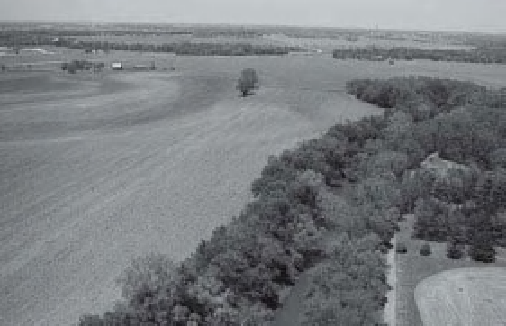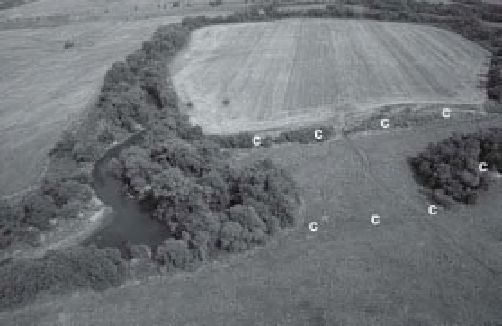Geoscience Reference
In-Depth Information
A
B
Figure 12-4.
Borders of riparian forest provide buffers between the river channel and agricultural i elds on the
l oodplain. A. Neosho River valley, east-central Kansas, United States. B. Hornád River valley on the border between
Slovakia (foreground) and Hungary (left background). The river here forms a large meander loop; two overl ow
l ood channels (c) cut across the narrow neck of the loop. Kite airphotos by S.W. Aber, J.S. Aber, and J. Jano
č
ko.
irrigation. Thus, this ingenious long-standing
practice not only provides protection from
storm water, but also services dependent agri-
i shing communities (Yin, Shan and Mao 2006).
Similarly, ponds excavated into l oodplains
across parts of West Africa and South America
provide i sh culture environments stocked with
i sh trapped by retreating l oods or through
aquaculture (Welcomme et al. 2006b).
Agricultural tiling involves the laying of per-
forated drainage tubes or pipes approximately
1 m below the soil surface to drain excess water
from wet i elds, ephemeral basins and other
low-lying areas into ditches. Agricultural tiling
was undertaken to help improve crop yields by
removing excess soil moisture and provide more
uniform growing and harvesting conditions
throughout an agricultural i eld. During the
nineteenth and twentieth centuries, extensive
sections of the United States' agricultural belt
were tiled to improve yields (Busman and Sands
2002). Conservation practices today recommend
the removal of these systems to recreate earlier
wetland conditions.
Vegetative buffer strips constructed and
maintained along riparian zones or protectively
encircling wetland sites provide some defense
from adjacent land-use stressors (Gregory et al.
1991). Buffers provide habitat transition zones
and may serve as corridor connectors for wild-
life moving between wetland sites (Kent 2000b).
They also help reduce the velocity of runoff
into streams and rivers, guarding against bank
erosion, and may aid in pollution abatement
through the uptake of nitrogen and phosphorus
(Fig. 12-4).
The construction of nesting platforms and
sites for wetland fauna and bird life is an essen-
tial management strategy employed in numer-
ous wetlands. Bird nest islands (Fig. 12-5),
artii cially controlled water levels, and manipu-
lated vegetation assemblages provide conditions
necessary to sustain migrating and nesting
populations.
The role of natural i re regimes in maintain-
ing ecosystem health has been well established.
Wetlands also experience natural i res which
help stimulate new growth, clear dead organic
matter and undesirable vegetation, release nutri-
ents, and open up bird nesting habitat (Kent
2000b). Prescribed and controlled burns within
wetland sites may be initiated for similar objec-
tives (see chapter 8.5). Additionally, controlled
burns are also undertaken to alter species com-
positions and often used to assist in eliminating
invasive species such as cattail (
Typha
sp.). The
timing of prescribed burns is an important con-
sideration and depends on the purpose of
the burn. Generally, burns to remove invasive
species are timed to coincide with seed germi-
nation cycles, while those undertaken to provide
bird habitat need to be completed well before
the breeding and nesting season (Laubhan and
Roelle 2001).






